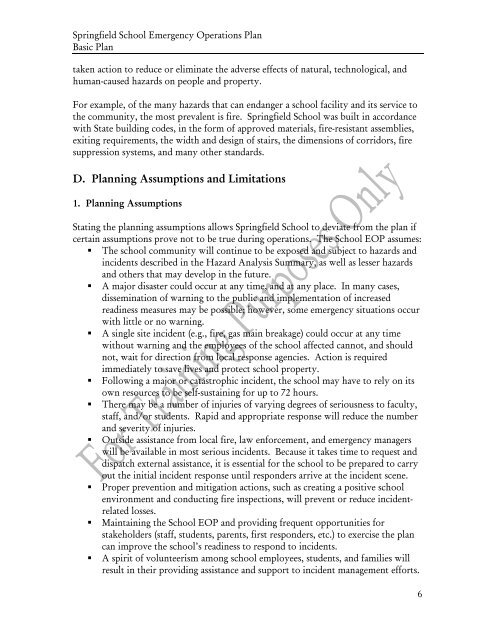Sample School Emergency Operations Plan
Sample School Emergency Operations Plan
Sample School Emergency Operations Plan
You also want an ePaper? Increase the reach of your titles
YUMPU automatically turns print PDFs into web optimized ePapers that Google loves.
Springfield <strong>School</strong> <strong>Emergency</strong> <strong>Operations</strong> <strong>Plan</strong><br />
Basic <strong>Plan</strong><br />
taken action to reduce or eliminate the adverse effects of natural, technological, and<br />
human-caused hazards on people and property.<br />
For example, of the many hazards that can endanger a school facility and its service to<br />
the community, the most prevalent is fire. Springfield <strong>School</strong> was built in accordance<br />
with State building codes, in the form of approved materials, fire-resistant assemblies,<br />
exiting requirements, the width and design of stairs, the dimensions of corridors, fire<br />
suppression systems, and many other standards.<br />
D. <strong>Plan</strong>ning Assumptions and Limitations<br />
1. <strong>Plan</strong>ning Assumptions<br />
Stating the planning assumptions allows Springfield <strong>School</strong> to deviate from the plan if<br />
certain assumptions prove not to be true during operations. The <strong>School</strong> EOP assumes:<br />
The school community will continue to be exposed and subject to hazards and<br />
incidents described in the Hazard Analysis Summary, as well as lesser hazards<br />
and others that may develop in the future.<br />
A major disaster could occur at any time, and at any place. In many cases,<br />
dissemination of warning to the public and implementation of increased<br />
readiness measures may be possible; however, some emergency situations occur<br />
with little or no warning.<br />
A single site incident (e.g., fire, gas main breakage) could occur at any time<br />
without warning and the employees of the school affected cannot, and should<br />
not, wait for direction from local response agencies. Action is required<br />
immediately to save lives and protect school property.<br />
Following a major or catastrophic incident, the school may have to rely on its<br />
own resources to be self-sustaining for up to 72 hours.<br />
There may be a number of injuries of varying degrees of seriousness to faculty,<br />
staff, and/or students. Rapid and appropriate response will reduce the number<br />
and severity of injuries.<br />
Outside assistance from local fire, law enforcement, and emergency managers<br />
will be available in most serious incidents. Because it takes time to request and<br />
dispatch external assistance, it is essential for the school to be prepared to carry<br />
out the initial incident response until responders arrive at the incident scene.<br />
Proper prevention and mitigation actions, such as creating a positive school<br />
environment and conducting fire inspections, will prevent or reduce incidentrelated<br />
losses.<br />
Maintaining the <strong>School</strong> EOP and providing frequent opportunities for<br />
stakeholders (staff, students, parents, first responders, etc.) to exercise the plan<br />
can improve the school’s readiness to respond to incidents.<br />
A spirit of volunteerism among school employees, students, and families will<br />
result in their providing assistance and support to incident management efforts.<br />
6
















